Starbucks Company Profile: Structure, Strategy, and Performance
VerifiedAdded on 2020/04/21
|7
|1419
|511
Report
AI Summary
This report provides a detailed company profile of Starbucks, the global coffeehouse chain. It begins with a historical overview, highlighting its establishment in 1971 and subsequent growth. The report examines Starbucks' matrix organizational structure, including functional, geographic, and product-b...
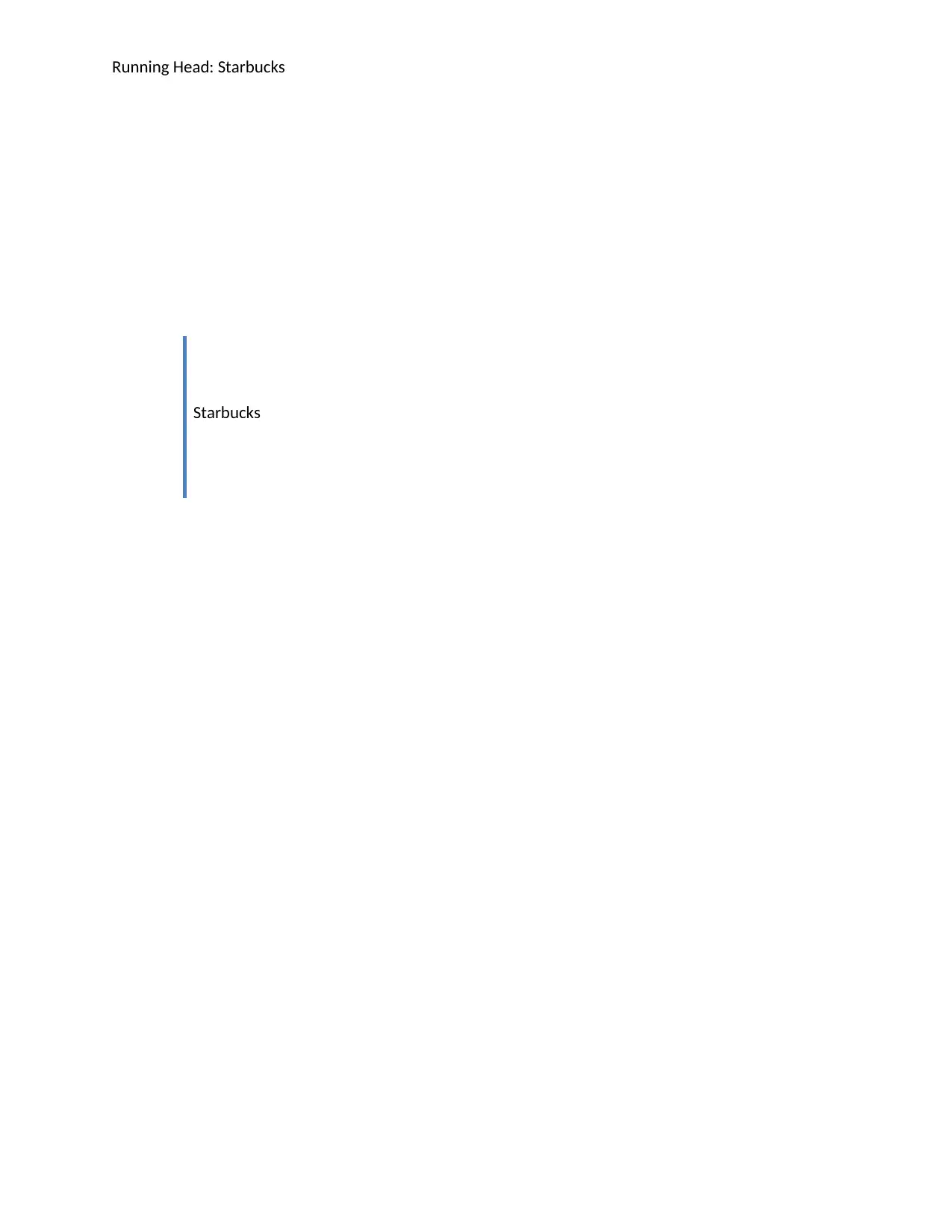
Running Head: Starbucks
Starbucks
Starbucks
Paraphrase This Document
Need a fresh take? Get an instant paraphrase of this document with our AI Paraphraser
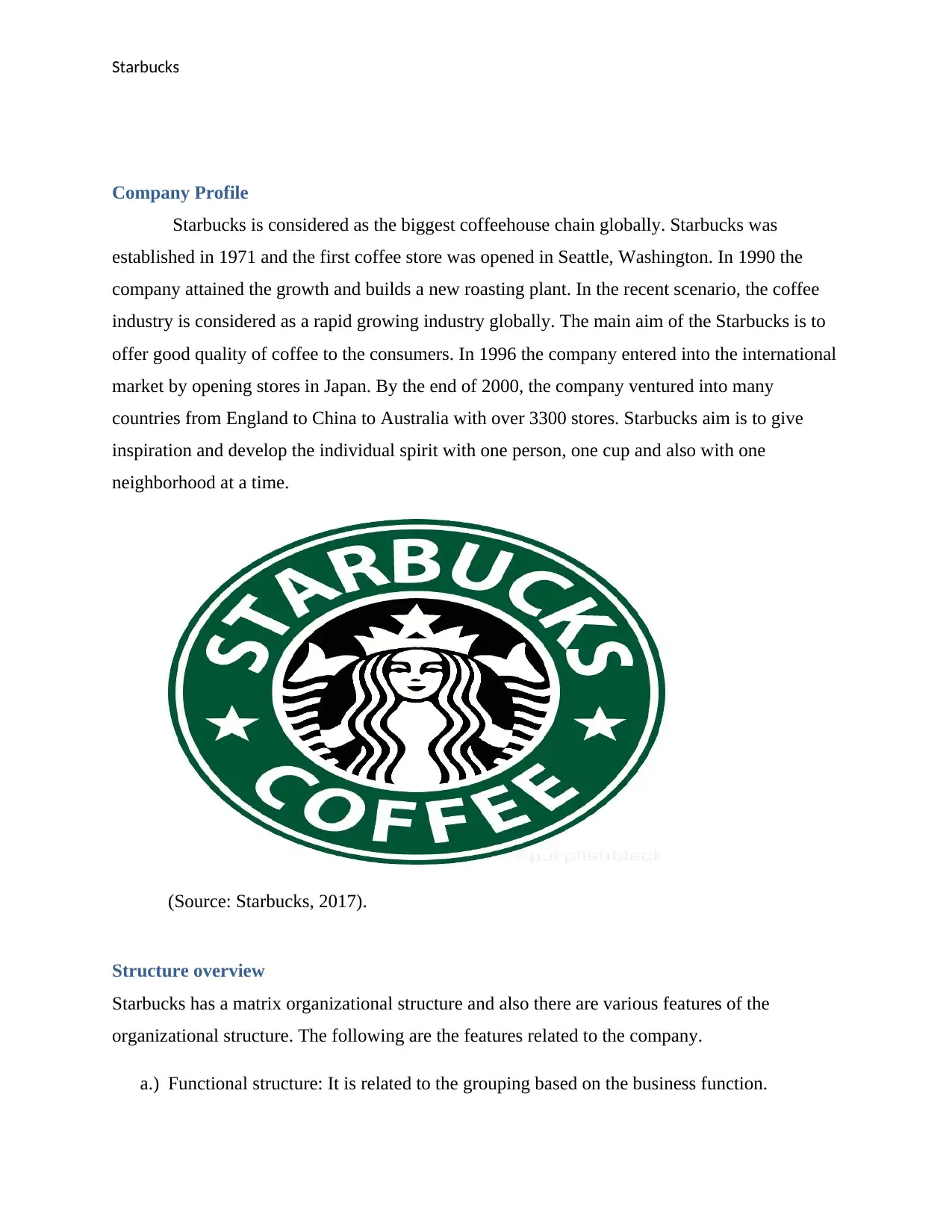
Starbucks
Company Profile
Starbucks is considered as the biggest coffeehouse chain globally. Starbucks was
established in 1971 and the first coffee store was opened in Seattle, Washington. In 1990 the
company attained the growth and builds a new roasting plant. In the recent scenario, the coffee
industry is considered as a rapid growing industry globally. The main aim of the Starbucks is to
offer good quality of coffee to the consumers. In 1996 the company entered into the international
market by opening stores in Japan. By the end of 2000, the company ventured into many
countries from England to China to Australia with over 3300 stores. Starbucks aim is to give
inspiration and develop the individual spirit with one person, one cup and also with one
neighborhood at a time.
(Source: Starbucks, 2017).
Structure overview
Starbucks has a matrix organizational structure and also there are various features of the
organizational structure. The following are the features related to the company.
a.) Functional structure: It is related to the grouping based on the business function.
Company Profile
Starbucks is considered as the biggest coffeehouse chain globally. Starbucks was
established in 1971 and the first coffee store was opened in Seattle, Washington. In 1990 the
company attained the growth and builds a new roasting plant. In the recent scenario, the coffee
industry is considered as a rapid growing industry globally. The main aim of the Starbucks is to
offer good quality of coffee to the consumers. In 1996 the company entered into the international
market by opening stores in Japan. By the end of 2000, the company ventured into many
countries from England to China to Australia with over 3300 stores. Starbucks aim is to give
inspiration and develop the individual spirit with one person, one cup and also with one
neighborhood at a time.
(Source: Starbucks, 2017).
Structure overview
Starbucks has a matrix organizational structure and also there are various features of the
organizational structure. The following are the features related to the company.
a.) Functional structure: It is related to the grouping based on the business function.
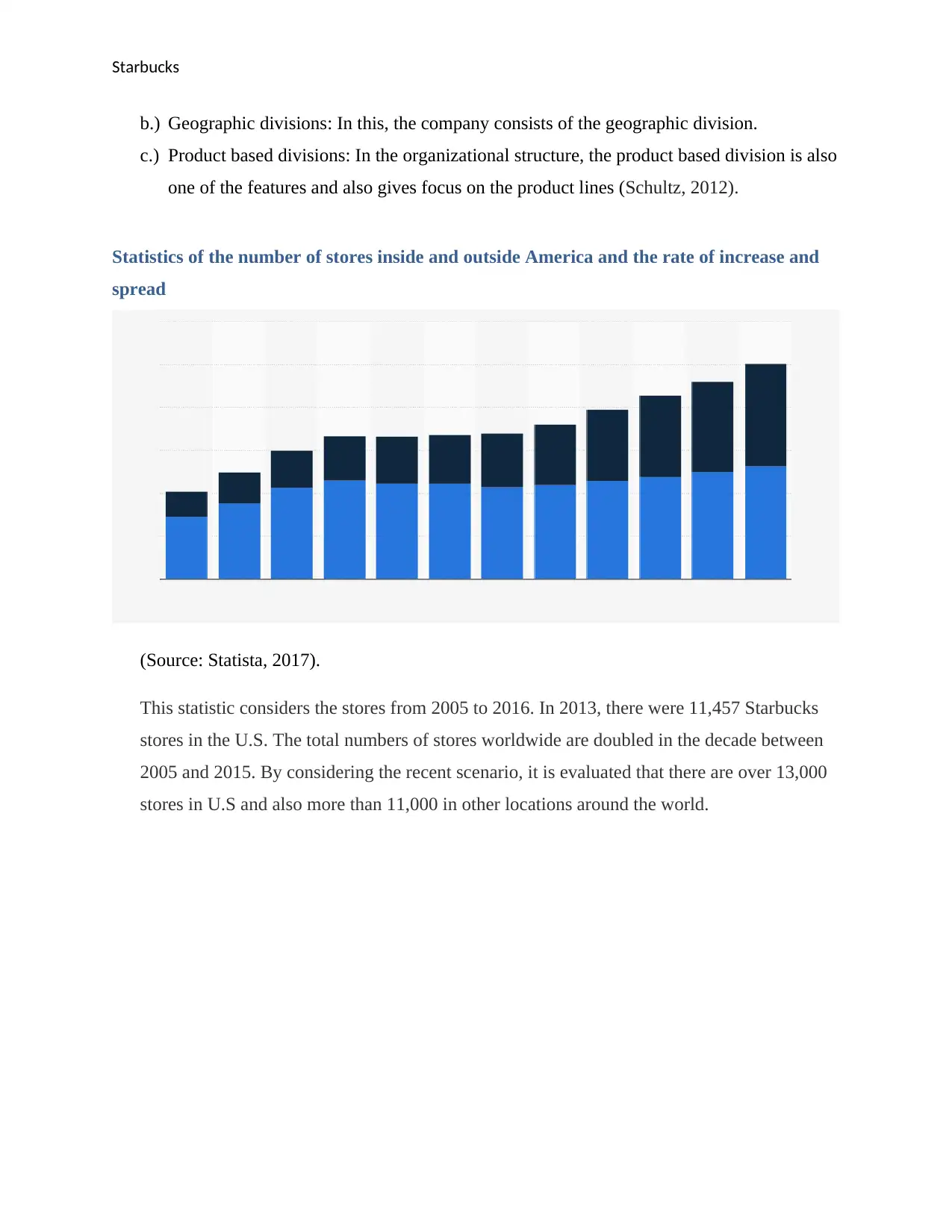
Starbucks
b.) Geographic divisions: In this, the company consists of the geographic division.
c.) Product based divisions: In the organizational structure, the product based division is also
one of the features and also gives focus on the product lines (Schultz, 2012).
Statistics of the number of stores inside and outside America and the rate of increase and
spread
(Source: Statista, 2017).
This statistic considers the stores from 2005 to 2016. In 2013, there were 11,457 Starbucks
stores in the U.S. The total numbers of stores worldwide are doubled in the decade between
2005 and 2015. By considering the recent scenario, it is evaluated that there are over 13,000
stores in U.S and also more than 11,000 in other locations around the world.
b.) Geographic divisions: In this, the company consists of the geographic division.
c.) Product based divisions: In the organizational structure, the product based division is also
one of the features and also gives focus on the product lines (Schultz, 2012).
Statistics of the number of stores inside and outside America and the rate of increase and
spread
(Source: Statista, 2017).
This statistic considers the stores from 2005 to 2016. In 2013, there were 11,457 Starbucks
stores in the U.S. The total numbers of stores worldwide are doubled in the decade between
2005 and 2015. By considering the recent scenario, it is evaluated that there are over 13,000
stores in U.S and also more than 11,000 in other locations around the world.
⊘ This is a preview!⊘
Do you want full access?
Subscribe today to unlock all pages.

Trusted by 1+ million students worldwide
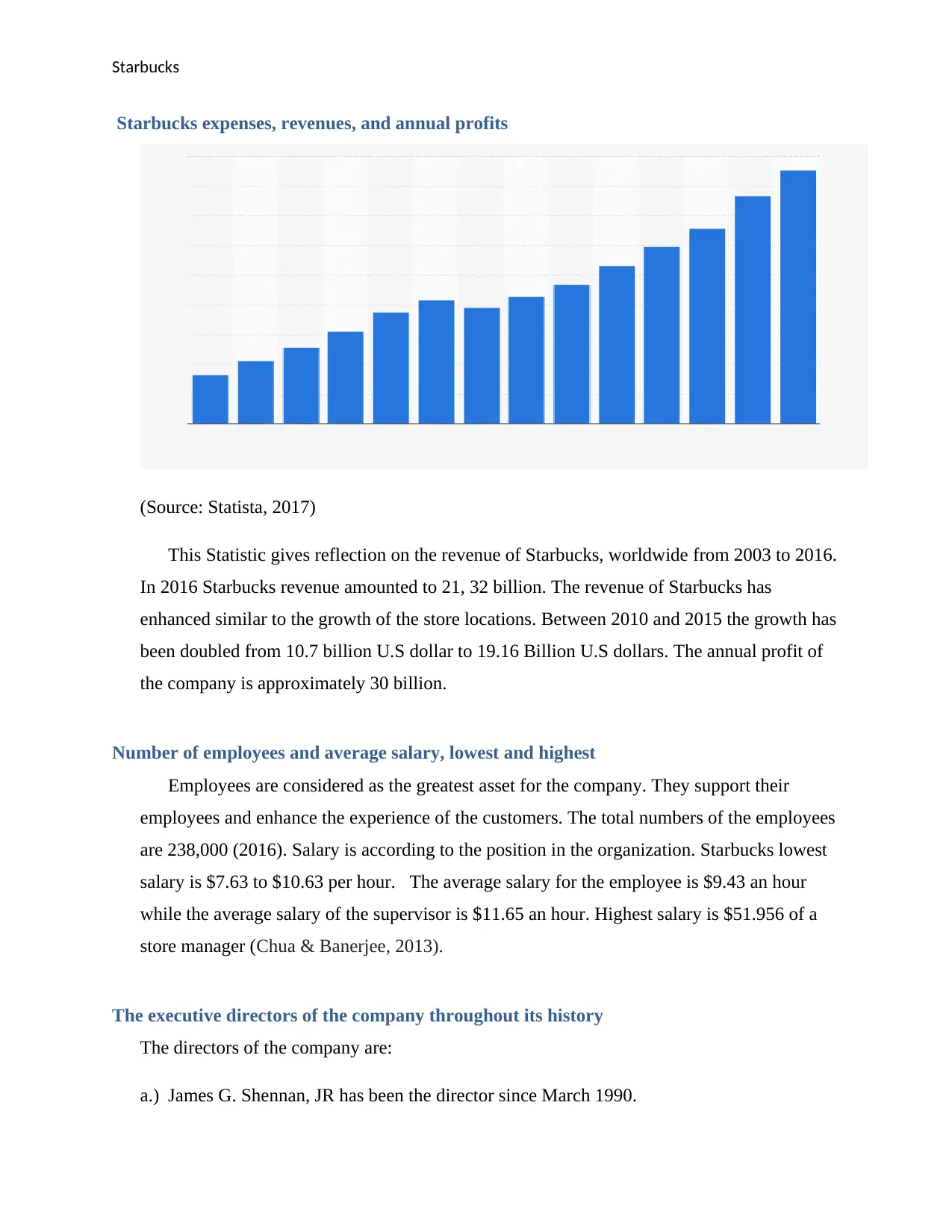
Starbucks
Starbucks expenses, revenues, and annual profits
(Source: Statista, 2017)
This Statistic gives reflection on the revenue of Starbucks, worldwide from 2003 to 2016.
In 2016 Starbucks revenue amounted to 21, 32 billion. The revenue of Starbucks has
enhanced similar to the growth of the store locations. Between 2010 and 2015 the growth has
been doubled from 10.7 billion U.S dollar to 19.16 Billion U.S dollars. The annual profit of
the company is approximately 30 billion.
Number of employees and average salary, lowest and highest
Employees are considered as the greatest asset for the company. They support their
employees and enhance the experience of the customers. The total numbers of the employees
are 238,000 (2016). Salary is according to the position in the organization. Starbucks lowest
salary is $7.63 to $10.63 per hour. The average salary for the employee is $9.43 an hour
while the average salary of the supervisor is $11.65 an hour. Highest salary is $51.956 of a
store manager (Chua & Banerjee, 2013).
The executive directors of the company throughout its history
The directors of the company are:
a.) James G. Shennan, JR has been the director since March 1990.
Starbucks expenses, revenues, and annual profits
(Source: Statista, 2017)
This Statistic gives reflection on the revenue of Starbucks, worldwide from 2003 to 2016.
In 2016 Starbucks revenue amounted to 21, 32 billion. The revenue of Starbucks has
enhanced similar to the growth of the store locations. Between 2010 and 2015 the growth has
been doubled from 10.7 billion U.S dollar to 19.16 Billion U.S dollars. The annual profit of
the company is approximately 30 billion.
Number of employees and average salary, lowest and highest
Employees are considered as the greatest asset for the company. They support their
employees and enhance the experience of the customers. The total numbers of the employees
are 238,000 (2016). Salary is according to the position in the organization. Starbucks lowest
salary is $7.63 to $10.63 per hour. The average salary for the employee is $9.43 an hour
while the average salary of the supervisor is $11.65 an hour. Highest salary is $51.956 of a
store manager (Chua & Banerjee, 2013).
The executive directors of the company throughout its history
The directors of the company are:
a.) James G. Shennan, JR has been the director since March 1990.
Paraphrase This Document
Need a fresh take? Get an instant paraphrase of this document with our AI Paraphraser
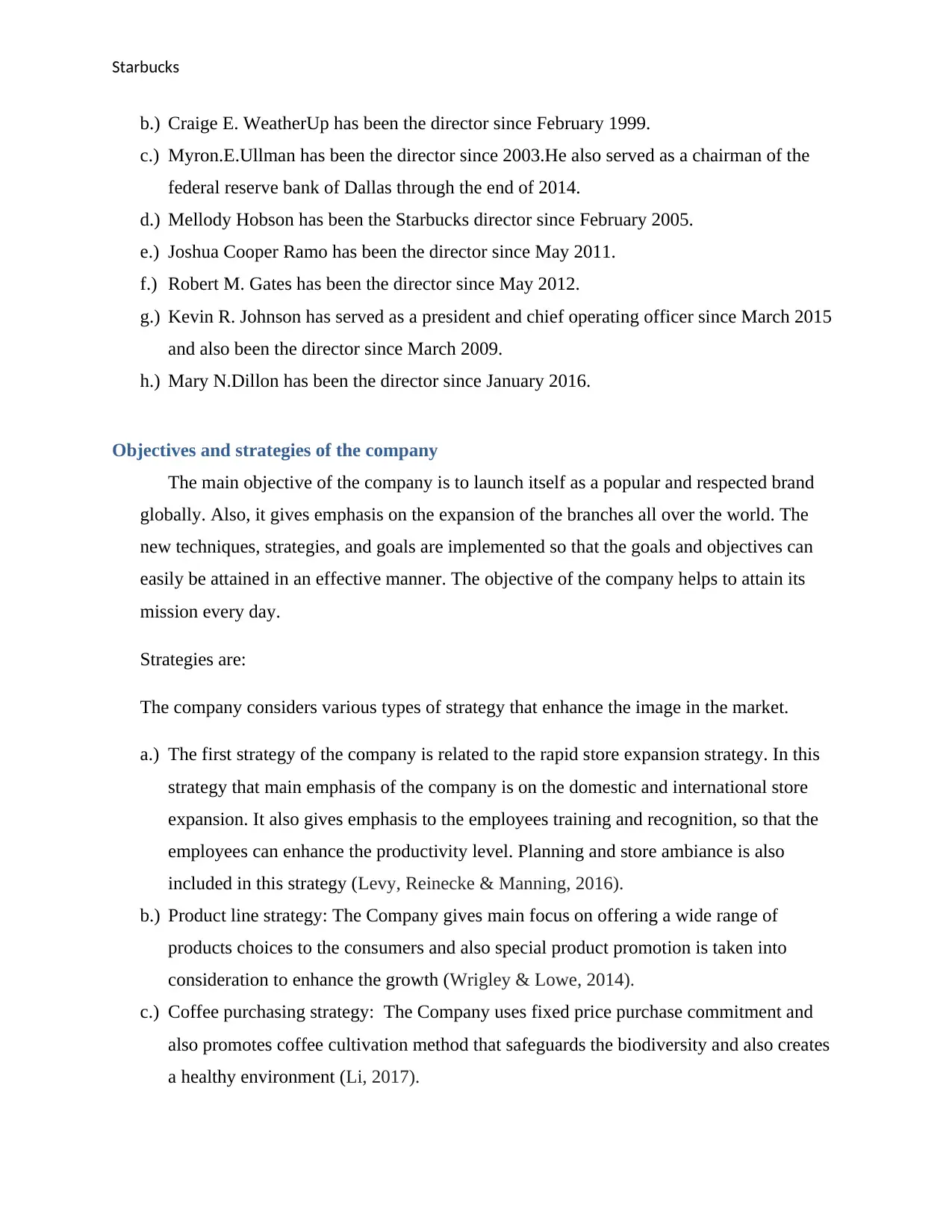
Starbucks
b.) Craige E. WeatherUp has been the director since February 1999.
c.) Myron.E.Ullman has been the director since 2003.He also served as a chairman of the
federal reserve bank of Dallas through the end of 2014.
d.) Mellody Hobson has been the Starbucks director since February 2005.
e.) Joshua Cooper Ramo has been the director since May 2011.
f.) Robert M. Gates has been the director since May 2012.
g.) Kevin R. Johnson has served as a president and chief operating officer since March 2015
and also been the director since March 2009.
h.) Mary N.Dillon has been the director since January 2016.
Objectives and strategies of the company
The main objective of the company is to launch itself as a popular and respected brand
globally. Also, it gives emphasis on the expansion of the branches all over the world. The
new techniques, strategies, and goals are implemented so that the goals and objectives can
easily be attained in an effective manner. The objective of the company helps to attain its
mission every day.
Strategies are:
The company considers various types of strategy that enhance the image in the market.
a.) The first strategy of the company is related to the rapid store expansion strategy. In this
strategy that main emphasis of the company is on the domestic and international store
expansion. It also gives emphasis to the employees training and recognition, so that the
employees can enhance the productivity level. Planning and store ambiance is also
included in this strategy (Levy, Reinecke & Manning, 2016).
b.) Product line strategy: The Company gives main focus on offering a wide range of
products choices to the consumers and also special product promotion is taken into
consideration to enhance the growth (Wrigley & Lowe, 2014).
c.) Coffee purchasing strategy: The Company uses fixed price purchase commitment and
also promotes coffee cultivation method that safeguards the biodiversity and also creates
a healthy environment (Li, 2017).
b.) Craige E. WeatherUp has been the director since February 1999.
c.) Myron.E.Ullman has been the director since 2003.He also served as a chairman of the
federal reserve bank of Dallas through the end of 2014.
d.) Mellody Hobson has been the Starbucks director since February 2005.
e.) Joshua Cooper Ramo has been the director since May 2011.
f.) Robert M. Gates has been the director since May 2012.
g.) Kevin R. Johnson has served as a president and chief operating officer since March 2015
and also been the director since March 2009.
h.) Mary N.Dillon has been the director since January 2016.
Objectives and strategies of the company
The main objective of the company is to launch itself as a popular and respected brand
globally. Also, it gives emphasis on the expansion of the branches all over the world. The
new techniques, strategies, and goals are implemented so that the goals and objectives can
easily be attained in an effective manner. The objective of the company helps to attain its
mission every day.
Strategies are:
The company considers various types of strategy that enhance the image in the market.
a.) The first strategy of the company is related to the rapid store expansion strategy. In this
strategy that main emphasis of the company is on the domestic and international store
expansion. It also gives emphasis to the employees training and recognition, so that the
employees can enhance the productivity level. Planning and store ambiance is also
included in this strategy (Levy, Reinecke & Manning, 2016).
b.) Product line strategy: The Company gives main focus on offering a wide range of
products choices to the consumers and also special product promotion is taken into
consideration to enhance the growth (Wrigley & Lowe, 2014).
c.) Coffee purchasing strategy: The Company uses fixed price purchase commitment and
also promotes coffee cultivation method that safeguards the biodiversity and also creates
a healthy environment (Li, 2017).
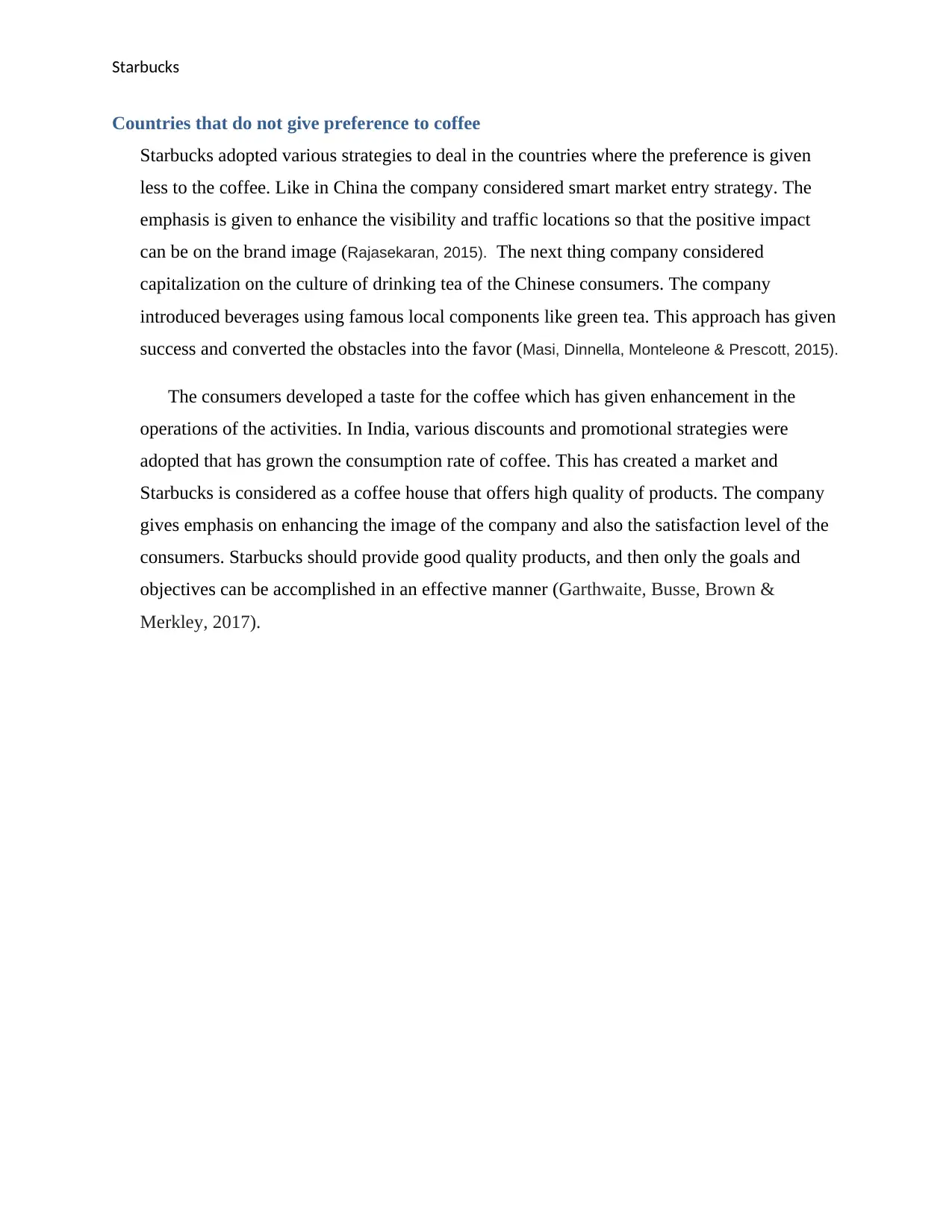
Starbucks
Countries that do not give preference to coffee
Starbucks adopted various strategies to deal in the countries where the preference is given
less to the coffee. Like in China the company considered smart market entry strategy. The
emphasis is given to enhance the visibility and traffic locations so that the positive impact
can be on the brand image (Rajasekaran, 2015). The next thing company considered
capitalization on the culture of drinking tea of the Chinese consumers. The company
introduced beverages using famous local components like green tea. This approach has given
success and converted the obstacles into the favor (Masi, Dinnella, Monteleone & Prescott, 2015).
The consumers developed a taste for the coffee which has given enhancement in the
operations of the activities. In India, various discounts and promotional strategies were
adopted that has grown the consumption rate of coffee. This has created a market and
Starbucks is considered as a coffee house that offers high quality of products. The company
gives emphasis on enhancing the image of the company and also the satisfaction level of the
consumers. Starbucks should provide good quality products, and then only the goals and
objectives can be accomplished in an effective manner (Garthwaite, Busse, Brown &
Merkley, 2017).
Countries that do not give preference to coffee
Starbucks adopted various strategies to deal in the countries where the preference is given
less to the coffee. Like in China the company considered smart market entry strategy. The
emphasis is given to enhance the visibility and traffic locations so that the positive impact
can be on the brand image (Rajasekaran, 2015). The next thing company considered
capitalization on the culture of drinking tea of the Chinese consumers. The company
introduced beverages using famous local components like green tea. This approach has given
success and converted the obstacles into the favor (Masi, Dinnella, Monteleone & Prescott, 2015).
The consumers developed a taste for the coffee which has given enhancement in the
operations of the activities. In India, various discounts and promotional strategies were
adopted that has grown the consumption rate of coffee. This has created a market and
Starbucks is considered as a coffee house that offers high quality of products. The company
gives emphasis on enhancing the image of the company and also the satisfaction level of the
consumers. Starbucks should provide good quality products, and then only the goals and
objectives can be accomplished in an effective manner (Garthwaite, Busse, Brown &
Merkley, 2017).
⊘ This is a preview!⊘
Do you want full access?
Subscribe today to unlock all pages.

Trusted by 1+ million students worldwide
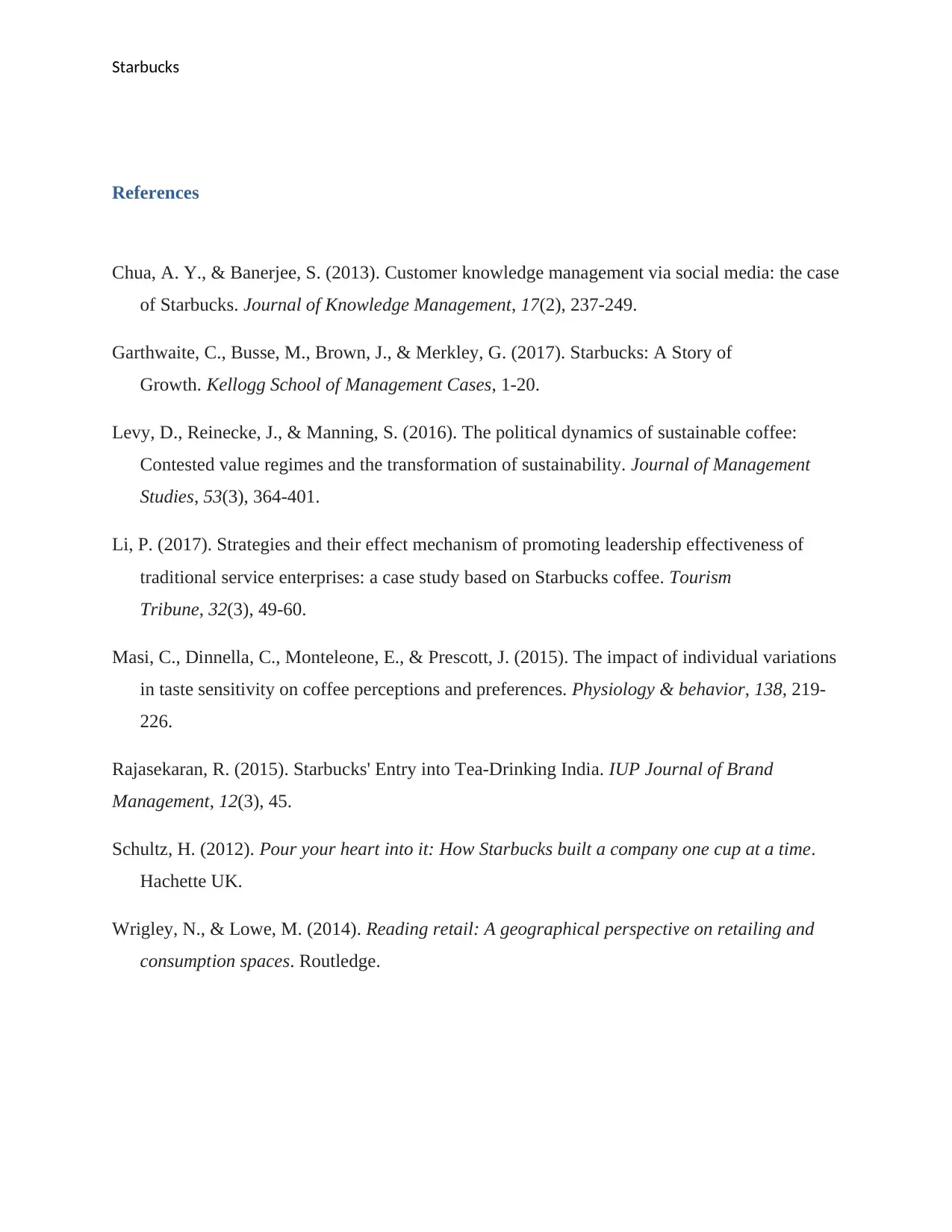
Starbucks
References
Chua, A. Y., & Banerjee, S. (2013). Customer knowledge management via social media: the case
of Starbucks. Journal of Knowledge Management, 17(2), 237-249.
Garthwaite, C., Busse, M., Brown, J., & Merkley, G. (2017). Starbucks: A Story of
Growth. Kellogg School of Management Cases, 1-20.
Levy, D., Reinecke, J., & Manning, S. (2016). The political dynamics of sustainable coffee:
Contested value regimes and the transformation of sustainability. Journal of Management
Studies, 53(3), 364-401.
Li, P. (2017). Strategies and their effect mechanism of promoting leadership effectiveness of
traditional service enterprises: a case study based on Starbucks coffee. Tourism
Tribune, 32(3), 49-60.
Masi, C., Dinnella, C., Monteleone, E., & Prescott, J. (2015). The impact of individual variations
in taste sensitivity on coffee perceptions and preferences. Physiology & behavior, 138, 219-
226.
Rajasekaran, R. (2015). Starbucks' Entry into Tea-Drinking India. IUP Journal of Brand
Management, 12(3), 45.
Schultz, H. (2012). Pour your heart into it: How Starbucks built a company one cup at a time.
Hachette UK.
Wrigley, N., & Lowe, M. (2014). Reading retail: A geographical perspective on retailing and
consumption spaces. Routledge.
References
Chua, A. Y., & Banerjee, S. (2013). Customer knowledge management via social media: the case
of Starbucks. Journal of Knowledge Management, 17(2), 237-249.
Garthwaite, C., Busse, M., Brown, J., & Merkley, G. (2017). Starbucks: A Story of
Growth. Kellogg School of Management Cases, 1-20.
Levy, D., Reinecke, J., & Manning, S. (2016). The political dynamics of sustainable coffee:
Contested value regimes and the transformation of sustainability. Journal of Management
Studies, 53(3), 364-401.
Li, P. (2017). Strategies and their effect mechanism of promoting leadership effectiveness of
traditional service enterprises: a case study based on Starbucks coffee. Tourism
Tribune, 32(3), 49-60.
Masi, C., Dinnella, C., Monteleone, E., & Prescott, J. (2015). The impact of individual variations
in taste sensitivity on coffee perceptions and preferences. Physiology & behavior, 138, 219-
226.
Rajasekaran, R. (2015). Starbucks' Entry into Tea-Drinking India. IUP Journal of Brand
Management, 12(3), 45.
Schultz, H. (2012). Pour your heart into it: How Starbucks built a company one cup at a time.
Hachette UK.
Wrigley, N., & Lowe, M. (2014). Reading retail: A geographical perspective on retailing and
consumption spaces. Routledge.
1 out of 7
Your All-in-One AI-Powered Toolkit for Academic Success.
+13062052269
info@desklib.com
Available 24*7 on WhatsApp / Email
![[object Object]](/_next/static/media/star-bottom.7253800d.svg)
Unlock your academic potential
© 2024 | Zucol Services PVT LTD | All rights reserved.

